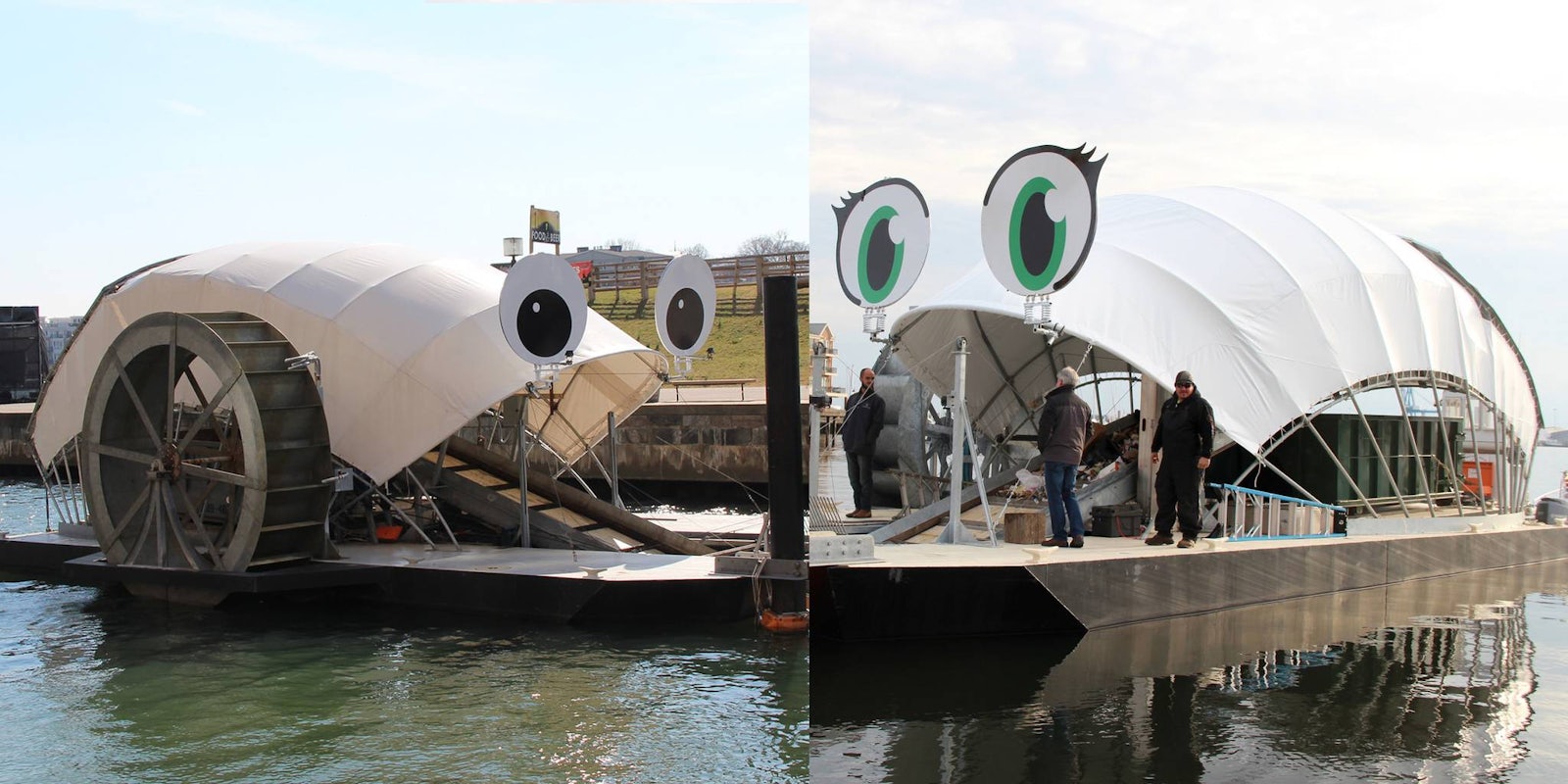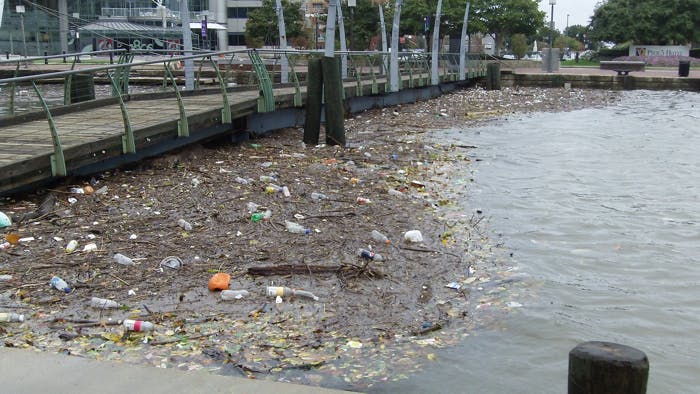In case the world needed another reason to care about water pollution and environmental issues, Baltimore has added googly eyes to the mix.
In response to trash overwhelming Baltimore’s harbor on the Chesapeake Bay, two so-called trash wheels were put in place to “eat” debris. These wheels have names, internet personalities, and heart-warming googly eyes.
Meet Mr. Trash Wheel and Professor Trash Wheel.
Waterfront Partnership of Baltimore, an environmental nonprofit in Maryland, has a program called the Healthy Harbor Initiative focused on cleaning the harbor that leads the trash wheel operations. Since 2014 two wheels have been put in place, sifting over a million pounds of trash from the water.
Adam Lindquist has served as the director of the Healthy Harbor Initiative since 2011, and saw Mr. Trash Wheel and Professor Trash Wheel go from the fundraising stage to full blown viral internet stars. Similarly, he’s seen the bay go from a harbor of trash back to a harbor of water.
“The harbor’s been a very polluted water body for decades now,” Lindquist told the Daily Dot. “We would get these rain storms that would pull everything from the storm drains into the streets and then that would go into the water. In certain spots the water couldn’t even be seen underneath the layer of trash.”
John Kellett of Clearwater Mills, creator of the trash wheels, told the National Geographic he was tired of seeing the harbor filled with trash for so many years, and wanted to create something to help. In 2008, Kellett created the original pilot trash wheel was smaller than the current models, and only had one dumpster. Mr. Trash Wheel officially came to the rescue in 2014.
“That initial pilot wheel was deemed too small for the size of trash that comes down Jones Creek, so it was eventually relocated to a smaller part of the harbor,” Lindquist told the Daily Dot. “We saw that it wasn’t perfect but had made a huge impact on the harbor and reached out to John and decided to partner up.”
Constellation Energy and Maryland Port Administration funded Mr. Trash Wheel with $700,000. Before the first wheel was finished, Lindquist said the group knew more were needed to keep the Inner Harbor clean.
Last December the initiative placed a second trash wheel, Professor Trash Wheel, about three miles east on the Inner Harbor from Mr. Trash Wheel.
This time around, the Waterfront Partnership launched a crowdfunding campaign that garnered roughly 600 donors all from the fanbase Mr. Trash Wheel’s Twitter account had created. Yes, the wheel’s Twitter account.
Lindquist posted a video to YouTube in May 2014 showing the trash wheel operating during a rainstorm. The video collected over a million views, leading Lindquist on a quest to gather more fame for the project. After reaching out to local creatives, a company recommended WP photoshop googly eyes onto photos of the trash wheel and launch a social media presence for the project.
Thus, Mr. Trash Wheel was born into Twitterdom.
@HealthyHarbor I love it when kayakers come visit me in the Harbor! Just don’t get too close or you could end up in my belly!
— Mr. Trash Wheel (@MrTrashWheel) July 15, 2014
Since then, the account has gained nearly 10,000 followers and committed fans across the globe.
https://twitter.com/MrKieren/status/820725726903205888
I wonder if @MrTrashWheel will be my friend. We both love eating garbage 🐶 #dogsoftwitter #feelthechurn pic.twitter.com/7juc9qjBXM
— Max (@MediumM_Max) December 18, 2016
We need you in Harbor East @MrTrashWheel!!! 😰😰 pic.twitter.com/qkmtckUk2e
— Towson Horse (@TowsonHorse) February 17, 2017
“We just wanted to keep the trash out of the harbor,” Lindquist said about the wheel’s popularity. “The expressions of love we get [from Twitter] almost daily are really incredible. People express real endearment for this inanimate object.”
Professor Trash Wheel debuted in December 2016 and is working on becoming just as popular. The second trash wheel’s Twitter account seems to focus on spreading the word about female scientists and their accomplishments to encourage young people to go into STEM careers.
Happy Birthday Thelma Estrin, a pioneer in the field of biomedical engineering. pic.twitter.com/6WjCg5B8xn
— ProfessorTrashWheel (@ProfTrashWheel) February 21, 2017
The idea that could eliminate ocean trash might reside in a young girl studying STEM. pic.twitter.com/XZUNtQgOYD
— ProfessorTrashWheel (@ProfTrashWheel) February 16, 2017
As for the future of trash wheels, Lindquist dreams of a day when they won’t be as necessary.
“We want to keep these trash wheels on a diet and actually reduce the amount of trash going into the harbor,” Lindquist said. “We see the trash wheels as a temporary solution when the big solution is behavioral change—for people to learn more about recycling and reducing waste.”
U.S. Environmental Protection Agency issued a Total Maximum Daily Load for trash and debris in the Baltimore Harbor of the Chesapeake Bay in 2015, prompting the city to financially support projects, like the wheels, to clean the water. With talk from the Trump administration dialing back the EPA, government funding for environmental projects like the wheels could diminish, or disappear completely.
Lindquist worries that without enforcement from a government agency, the city will stop funding the Healthy Harbor Initiative. Though he feels regulations should be in place to keep cities and other entities accountable, he’s optimistic about the public’s support for environmental efforts.
“Without incentive, I think it would be more difficult to keep the water clean,” Lindquist said. “I do feel like there would be a backlash from the public and people would be more impassioned to fund these kinds of projects.”
So far, the adorable personifications of the wheels have already inspired many people to become more conscious of their waste habits. The googly eyes of Mr. and Professor Trash Wheel are upon the people of Maryland—and the rest of the world.



